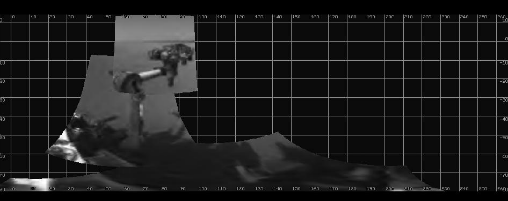NASA's Mars rover Curiosity on Monday flexed its 7-foot-long robotic arm for the first time since it landed on Mars.
Monday's robotics maneuver had the rover checking its motors and joints by unstowing the arm, extending it using all five joints and then stowing it again.

Mars Curiosity extends its robotic arm. Image: Courtesy of NASA.
Click to view larger image
NASA noted that weeks of testing and calibrating arm movements will lie ahead before the arm will capture its first soil samples and deliver them to Curiosity's scientific instruments.
"We have had to sit tight for the first two weeks since landing, while other parts of the rover were checked out, so to see the arm extended in these images is a huge moment for us," said Matt Robinson, a lead engineer for Curiosity's robotic arm. "The arm is how we are going to get samples into the laboratory instruments and how we place other instruments onto surface targets."
The robotic arm maneuvers a turret of tools, including a camera, drill, spectrometer, a scoop and devices for sieving and portioning soil and powdered rock samples.
The arm's turret has a mass of about 66 pounds and it's nearly two-feet in diameter.
Curiosity's robotic rover predecessors on Mars -- Spirit and Opportunity -- also were built with robotic arms. However, Curiosity's arm is much bigger.
Louise Jandura, a chief engineer on Curiosity's robotic arm team, told Computerworld that the older rovers have two and a half foot-long arms, while Curiosity's is seven feet long. And she noted that the tools on the new arm also are much more capable.
Curiosity also successfully completed another big test just this past Sunday, testing its laser by blasting a fist-size Martian rock and analyzing its makeup.
The rover's Chemistry and Camera instrument, dubbed the ChemCam, zapped the rock with 30 pulses during a 10-second span. With each pulse carrying more than a million watts of power in a five one-billionth-of-a-second burst, the laser turned the rock, which scientists named Coronation, into an ionized, glowing plasma.
Then the ChemCam, which sits on the rover's mast, caught the light from the plasma with a telescope and analyzed the specimen with three spectrometers to discover what the rocks are made of.
Another major test is coming up. The rover is about to actually move across the Martian surface for the first time.
The first movements won't be a long trek, but they will have Curiosity move back and forth on its landing site to test its wheels and motors. This test is expected within the next few days.
Once Curiosity's ability to drive is successfully tested, scientists will turn their attention to plotting the rover's first real trip, which will take it to an area NASA dubbed Glenelg, which marks the intersection of three different kinds of terrain. The trip is expected to take three to four weeks.
Then, toward the end of the year, Curiosity is expected to begin its trek to Mount Sharp, a three mile-high mountain in the middle of Gale Crater, where the rover landed. The mountain is a key area of interest for NASA scientists who are trying to determine if Mars was ever capable of supporting any type of life.
The car-size, nuclear-powered rover is on what NASA hopes will be at least a two-year mission. It is equipped with 10 scientific instruments and offers the most advanced payload of scientific gear ever used on the surface of Mars, including chemistry instruments, environmental sensors and radiation monitors.
Late on Monday afternoon, NASA announced that it will launch a new mission, named InSight, in 2016 to try to discover whether the core of Mars is solid or liquid like Earth's, and why Mars' crust is not divided into tectonic plates that drift like they do on Earth.
That mission will involve a lander working near the Martian equator. The lander will carry two cameras, a robotic arm, a thermal probe to gauge the planet's temperature and a sensor to determine how much the planet wobbles on its axis. It will also carry an instrument to measure seismic waves traveling through the planet's interior.





